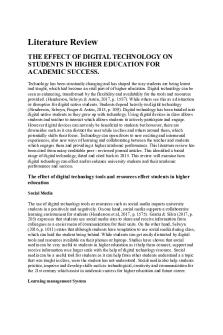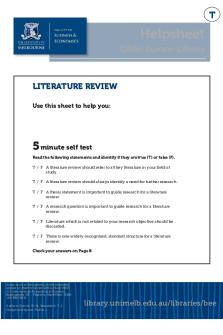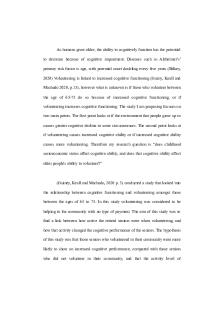BABS1201 2021 T3 Literature review PDF

| Title | BABS1201 2021 T3 Literature review |
|---|---|
| Course | BABS1201 |
| Institution | University of New South Wales |
| Pages | 5 |
| File Size | 145.5 KB |
| File Type | |
| Total Downloads | 77 |
| Total Views | 157 |
Summary
assessment guide...
Description
Literature review A literature review is a descriptive summary of research on a topic that has previously been studied. The purpose of a literature review is to inform readers of the significant knowledge and ideas that have been established on a topic. Its purpose is to compare, contrast and/or connect findings that were identified when reviewing researchers' work. Due date: Friday Week 5, 5 pm via the Turnitin submission box in the Assessments section of Moodle. PLEASE check the Course Outline and the Assessment section on Moodle for information. Ensure you do not attempt to upload minutes prior to the deadline as, due to the number of students in the course, you WILL experience difficulties and risk your assignment submitting late. Weighting: 15% The literature review assesses some of the learning outcomes from the Scientific Literature lecture and online lesson and develops some Graduate Attributes and the Biology Threshold Learning Outcomes.
Instructions As a team of approximately four, choose your topic from the list below. The link will provide you with some information on the topic to help with your choice. Remember: you need to find scientific articles using a database, you do not simply use the popular science piece linked to as your 'article'. You should aim to find at least five articles, including one review. It is highly recommended that you complete the online lesson on how to search the scientific literature located on the course Moodle site.
Criteria Your literature review will be assessed on the following criteria, these are included in the marking rubric found on the 'Assessments' section of Moodle: 1. Introduce the topic. Include a title that clearly outlines the topic of the review. Clearly indicate the topic, provide some background and describe how you will organise the information. 2. Content. Using your scientific articles, articulates the main points clearly & interpret the results of the sources to develop a logical analysis of the area. Superior responses will how an understanding of strengths & limitations of the literature used. 3. Conclusion. Succinct and precise statements based on your review of the literature. Superior responses will synthesise the information from the articles to give new insights and conclusions. 4. Readability. Writing is clear, and succinct with proofreading performed. The material is well organised and logically structured, with clear breaks yet logical connections between introduction, body paragraphs, and conclusion. 5. References. References primarily peer reviewed professional journals or other approved sources. In text citations formatted correctly. Reference list formatted correctly, using APA style. EDIT: As the referencing lesson on Moodle described Harvard style, you may choose this or APA. Use at least 5 peer-reviewed journal articles, including one review (for some topics these may be broadly related), on your topic and write a 2000 word literature review on the articles you've selected.
1
References You must reference your articles at the end of your literature review. A module on how to find and reference scientific articles correctly is available on Moodle, this provides a suggested referencing style and explains how to use in text citations. Further information is here: https://student.unsw.edu.au/referencing
Word count The word count is 2000, excluding references. You must perform a word count and indicate the count at the beginning of your literature review. You will not be penalised for going over by 10%. You will not be penalised for being under the limit, but take care to ensure you adequately cover the information.
Plagiarism Please revise the information on academic integrity and plagiarism here before commencing your literature review: https://student.unsw.edu.au/plagiarism Tip: Close or put away all references or other resources when writing your literature review to ensure you only use your own words. You are writing for an audience of BABS1201 students so paraphrasing from a scientific paper will also not be an appropriate style. Write in your own words and 'fact check' anything you are unsure of after writing your first draft.
Need more help? Ask questions on the forum, in your laboratory class and in the Monday Q&A sessions. You may also contact 'Smart thinking' if you would like you literature review read over: https://student.unsw.edu.au/smarthinking
Topics If you are interested in a topic that is not listed, please discuss it with your demonstrator and have them contact me to approve it. 1. What controlled our circadian clock (24 hour cycle)? https://www.sciencedaily.com/releases/2021/08/210819134327.htm 2. What the microbiome of your house tells scientists about you. https://www.newyorker.com/tech/annals-of-technology/what-your-dust-says-about-you 3. Why are elephants less likely to get cancer? https://www.nationalgeographic.com/science/article/news-cancer-elephants-genes-dna-newresearch 4. How do mRNA vaccines work? https://www.sciencealert.com/the-pfizer-and-moderna-vaccines-are-a-breakthrough-here-show-they-work 5. Yeast 2.0: How to build a genome. http://www.issuesmagazine.com.au/article/issue-september2014/yeast-20-how-build-genome.html 6. What does the koala genome tell us about the taste of eucalyptus? https://www.sciencedaily.com/releases/2018/07/180710101646.htm
2
7. This animal can survive without oxygen, but how? https://www.sciencealert.com/scientists-find-the-first-animal-that-doesn-t-need-oxygen-tosurvive 8. How to sequence the genome of a woolly mammoth and what we have learnt from it. https://www.nationalgeographic.co.uk/science-and-technology/2021/02/million-year-oldmammoth-teeth-yield-worlds-oldest-dna 9. The Tardigrade (water bear) genome has been sequenced and it’s even weirder than we thought https://sciencealert.com/the-tardigrade-genome-has-been-sequenced-and-it-has-themost-foreign-dna-of-any-animal 10. The science of genetic inheritance is weirder than we thought http://www.sciencealert.com/watch-the-science-of-genetic-inheritance-is-weirderthan-we-thought 11. Gene-editing technique used to create low-gluten bread suitable for celiacs http://www.iflscience.com/health-and-medicine/geneediting-technique-used-tocreate-lowgluten-bread-suitable-for-celiacs/ 12. This biohacker became the first person to edit their own DNA http://www.iflscience.com/healthand-medicine/this-biohacker-became-the-first-person-to-edit-his-own-dna/ 13. CRISPR gene editing tool used to treat genetic disease in an animal for the first time http://www.sciencealert.com/crispr-gene-editing-tool-used-to-treat-genetic-disease-in-ananimal-for-the-first-time 14. A protein found in human breast milk could help kill drug resistant bacteria http://www.sciencealert.com/a-protein-found-in-human-breast-milk-could-help-killdrug-resistant-bacteria 15. Do we all carry the genes for autism? http://www.sciencealert.com/we-all-carry-the-genes-forautism-study-finds 16. The first eukaryotes without a normal cellular power supply have been found http://www.sciencemag.org/news/2016/05/first-eukaryotes-found-without-normalcellular-power-supply 17. Humans are still evolving and we can watch it happen http://www.sciencemag.org/news/2016/05/humans-are-still-evolving-and-we-canwatch-it-happen 18. Scientists have found a woman whose eyes have a whole new type of colour receptor http://www.sciencealert.com/scientists-have-found-a-woman-whose-eyes-have-awhole-new-type-of-colour-receptor 19. Scientists think they finally know why our genes are made of DNA and not RNA http://www.sciencealert.com/scientists-think-they-finally-know-why-our-genes-are-madeof-dna-not-rna
3
20. Forget what you learned in high school – this new carbon molecule has 6 bonds http://www.sciencealert.com/forget-what-you-learned-in-high-school-this-new-carbonmolecule-has-6-bonds 21. We might finally know what triggered living cells to evolve for the first time http://www.sciencealert.com/scientists-might-have-discovered-what-allowed-life-toevolve 22. Scientists have successfully reversed DNA aging in mice http://www.sciencealert.com/scientistshave-successfully-reversed-dna-ageing-in-mice 23. The energy generators inside our cells reach a sizzling 50°C https://www.newscientist.com/article/2129849-the-energy-generators-inside-our-cellsreach-a-sizzling-50c/ 24. Antibody-powered nucleic acid release using a DNA-based nanomachine https://www.nature.com/articles/ncomms15150 25. High intensity workouts could slow down your aging by almost a decade http://www.iflscience.com/health-and-medicine/highintensity-workouts-could-slowdown-your-aging-by-almost-a-decade/ 26. A new study identifies 52 genes associated with human intelligence https://www.facebook.com/nature/posts/10154856218303167 27. This Is the first ever nanoscale image of a living cell membrane. It's beautiful. http://www.sciencealert.com/researchers-close-a-debate-with-a-nanoscale-image-ofa-living-cell-membrane 28. Gastric bypass surgery gives patients a new set of helpful microbes http://www.sciencealert.com/gastric-bypass-surgery-gives-patients-a-new-set-ofhelpful-microbes 29. Can gene therapy be used to switch off asthma? http://www.sciencealert.com/gene-therapyused-to-switch-off-asthma 30. Tea consumption leads to epigenetic changes in women https://medicalxpress.com/news/201705-tea-consumption-epigenetic-women.html 31. Designer viruses successfully stimulate the immune system to fight cancer https://www.technologynetworks.com/cancer-research/news/designer-virusessuccessfully-stimulate-the-immune-system-to-fight-cancer-289203 32. Scientists discover plants have ‘brains’ that determine when they grow http://www.iflscience.com/plants-and-animals/scientists-discover-plants-brainsdetermine-grow/ 33. Latest DNA analysis shows the Yeti are actually just a bunch of bears http://www.sciencealert.com/dna-analysis-yeti-samples-asian-bears-no-proof-of-cryptids
4
34. Babies who get more cuddles have their genetics changed for years http://www.sciencealert.com/cuddling-babies-alters-their-genetics-dna-for-years 35. Living bacteria “From outer space” have been found on the outside of the ISS http://www.sciencealert.com/living-bacteria-from-outer-space-found-clinging-to-iss-alienlife 36. This protein in your brain could be at the heart of creating memories http://www.sciencealert.com/rna-binding-protein-staufen2-linked-to-synapticplasticity-learning-memory 37. World’s smallest tape recorder has been built inside a living bacterium http://www.sciencealert.com/smallest-tape-recorder-crispr-cas-bacterium
5...
Similar Free PDFs

Literature Review
- 10 Pages

Literature Review
- 9 Pages

Literature Review
- 6 Pages

Literature Review
- 32 Pages

Literature Review
- 9 Pages

Literature Review
- 5 Pages

Literature Review
- 15 Pages

Literature Review
- 4 Pages

Literature Review
- 16 Pages

Reading Guide T3 2021
- 2 Pages

BABS1201-2 - Google Docs
- 55 Pages

Jamovi Laboratory Manual T3 2021
- 60 Pages

ARTS2455 2021 T3 Course Outline
- 13 Pages

Systematic Literature Review
- 9 Pages

Mobile Learning Literature Review
- 26 Pages
Popular Institutions
- Tinajero National High School - Annex
- Politeknik Caltex Riau
- Yokohama City University
- SGT University
- University of Al-Qadisiyah
- Divine Word College of Vigan
- Techniek College Rotterdam
- Universidade de Santiago
- Universiti Teknologi MARA Cawangan Johor Kampus Pasir Gudang
- Poltekkes Kemenkes Yogyakarta
- Baguio City National High School
- Colegio san marcos
- preparatoria uno
- Centro de Bachillerato Tecnológico Industrial y de Servicios No. 107
- Dalian Maritime University
- Quang Trung Secondary School
- Colegio Tecnológico en Informática
- Corporación Regional de Educación Superior
- Grupo CEDVA
- Dar Al Uloom University
- Centro de Estudios Preuniversitarios de la Universidad Nacional de Ingeniería
- 上智大学
- Aakash International School, Nuna Majara
- San Felipe Neri Catholic School
- Kang Chiao International School - New Taipei City
- Misamis Occidental National High School
- Institución Educativa Escuela Normal Juan Ladrilleros
- Kolehiyo ng Pantukan
- Batanes State College
- Instituto Continental
- Sekolah Menengah Kejuruan Kesehatan Kaltara (Tarakan)
- Colegio de La Inmaculada Concepcion - Cebu
